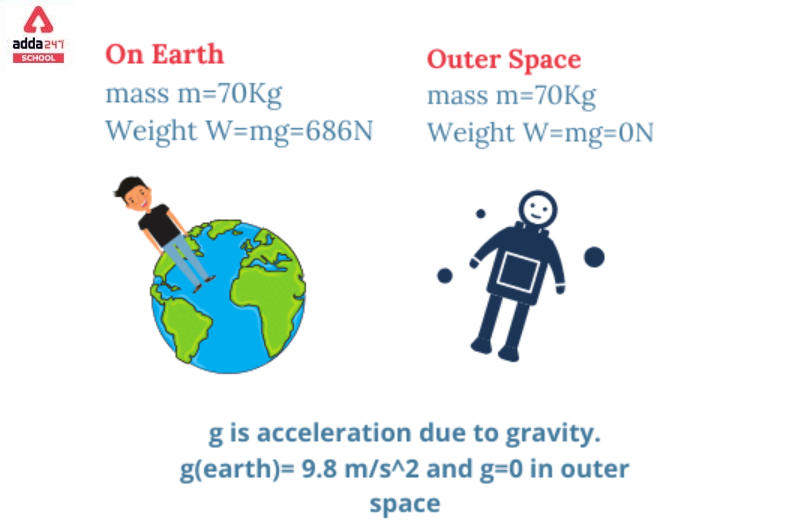Among the most commonly asked issues, what is the difference between mass and weight, is among the top. For several pupils, this is a very complex topic, and people sometimes use the terms mass and weight interchangeably, which is improper. There are various distinctions between mass and weight, and it is vital to understand what they are and how they are related before moving on to the mass and weight discrepancy.
Difference Between Mass and Weight
Your mass remains constant regardless of where you are in the cosmos, but your weight varies. Although mass is measured in kilograms, it should be measured in newtons, which are force units.
Mass is a measure of how much force it will take to change an object’s state of motion, and mass is a measure of how much force it will take to change that course. Furthermore, mass is a measure of how much matter – atoms and other particles – is contained in a thing, whereas weight is a measure of the downward force exerted by gravity on an object.
Mass and Weight Difference
Many students are perplexed about the primary distinctions between mass and weight, and it is critical to understand this issue thoroughly because it is a vital part of the mechanics section of physics. Questions based on difference between mass and weight differences are frequently included in competitive exams, and even for the basics, students are required to understand the fundamentals of mass and weight, as well as the formulas for determining weight and mass, which is critical even from an examination standpoint.
What is the Difference Between Mass and Weight
Mass is a measure of the amount of matter in an object and is constant, regardless of location. It is typically measured in kilograms (kg). Weight, on the other hand, is the force exerted by gravity on that mass. Weight depends on the gravitational pull of the location where the object is and is measured in newtons (N). On Earth, weight can be calculated by multiplying mass by the acceleration due to gravity (approximately 9.8 m/s²). Thus, while mass remains the same everywhere, weight varies with changes in gravity, such as on the Moon or other planets.
What is Mass
The number of protons, neutrons, and electrons in an object can be used to calculate its mass. In other words, mass refers to both a physical attribute and a measurement of an object’s resistance to acceleration when a net force is applied, and the most common units for mass are kilograms and grams.
It is the resistance supplied by a body of matter to a change in its speed or position when force is applied, and it can be referred to as the quantitative measure of inertia.
Thus, the bigger a body’s mass, the smaller the change that occurs when force is applied, and while kg is the globally recognized unit of mass, other units such as gram, milligram, tonnes, and pounds are also used.
All astronauts aboard the International Space Station, who are weightless, have mass in their physical bodies.
Mass can never be zero, and it can be measured with any conventional balance, such as a beam balance, lever balance, or pan balance.
Mass is a scalar quantity since it is a base quantity with only one magnitude.
What is Weight
The amount of force acting on a mass due to acceleration due to gravity is measured in weight, and the weight of an object refers to the force acting on an object due to gravity. It is sometimes defined as a vector quantity that represents the gravitational force acting on the item, while others define it as a scalar quantity that represents the gravitational force’s magnitude. The weight is the gravitational interaction between items with mass when they interact with the Earth, and the weight’s unit is Newton and pound.
The gravitational pull of the earth is what attracts an object or body to it, and weight is the force that is accountable for it. As a result, the unit of weight equals the unit of force. It is based on the notion that force and weight are equal.
Furthermore, because an object’s weight is proportional to its mass, an increase in mass will result in an increase in weight.
Weight is a derived quantity that is a vector quantity because it has both magnitude and direction (towards the center of gravity).
A spring balance or the formula (Weight = mass x acceleration due to gravity) can be used to calculate the weight.
Difference Between Mass and Weight in Tabular Form
Difference between mass and weight in tabular form is given below:
| Difference | Mass (M) | Weight (W) |
| Definition | Mass is simply the measure of the amount of matter in a body. | Weight is the measure of the amount of force acting on a mass due to acceleration due to gravity. |
| Formula | Mass is always constant for a body and there are several formulas to calculate mass.
Formula is: Mass = volume × density |
Weight is the measure of the gravitational force acting on a body.
Formula is: Weight = mass × acceleration due to gravity |
| Quantity Type | Mass is a base quantity.
Mass only has magnitude and so, it is a scalar quantity. |
Weight is a derived quantity.
Weight has both magnitude and direction (towards the center of gravity) and so, it is a vector quantity. |
| Unit of Measurement | The SI unit of mass is Kilogram (Kg). | The SI unit of weight is Newton (N). |
| Gravitational Effect | Mass does not depend upon gravity and is constant everywhere.
Mass can never be zero. |
Weight is dependent on gravity and so, it varies from place to place.
Weight can be zero where there is no gravity (like space). |
| Measuring Instrument | Mass can be easily measured using any ordinary balance like beam balance, lever balance, pan balance, etc. | Weight can be measured by a spring balance or by using its formula. |
| Meaning | Mass is the measure of inertia. | Weigh is the measure of force. |
| Location | It stays the same everywhere, irrespective of location. | Weight will vary depending on the location. |
| Physical Quantity | Mass is a scalar quantity. It has magnitude. | It is a vector quantity. It’s got the magnitude and directs toward the Earth’s center or other gravity. |
| SI Unit | The SI unit of mass is the kilogram (kg). | Weight’s SI unit is Newton (N). |
| Measurement | We measure it using an ordinary balance. For instance, pan balance, beam balance, etc. | We can measure weight using a spring balance. |
| Denotation | ‘M’ is used to denote Mass. | We use ‘W’ to denote weight. |
Mass vs Weight
Mass and weight are related but distinct concepts in physics:
Mass:
- Definition: Mass is the amount of matter in an object.
- Units: Measured in kilograms (kg), grams (g), etc.
- Property: It is a scalar quantity and does not change regardless of location.
- Nature: Mass is a measure of an object’s inertia, or resistance to change in motion.
- Formula: Mass is often denoted by “m” and does not require a formula as it is an inherent property of matter.
Weight:
- Definition: Weight is the force exerted on an object due to gravity.
- Units: Measured in newtons (N), since it is a force.
- Property: It is a vector quantity and can change depending on the gravitational field strength.
- Nature: Weight depends on both the mass of the object and the acceleration due to gravity.
- Formula:
is the weight,
is the mass,
is the acceleration due to gravity (approximately 9.8 m/s² on Earth).
Key Differences:
- Mass is intrinsic and does not change based on location.
- Weight varies with the gravitational force at a specific location.
- An object on the Moon weighs less than on Earth because the Moon’s gravity is weaker, but its mass remains the same.
Other Related Posts –









 DTE Maharashtra Polytechnic Merit List 2...
DTE Maharashtra Polytechnic Merit List 2...
 How Normalisation Influence CUET Score 2...
How Normalisation Influence CUET Score 2...
 CUET Result 2025 OUT SHORTLY @cuet.nta.n...
CUET Result 2025 OUT SHORTLY @cuet.nta.n...









